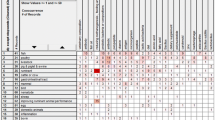Abstract
Technology assessment survey is nowadays a specific and scientific subject that any manufacture needs for increasing productivity. This function was initially reserved to experts of the studied field. But the increase of information volume has called for a change. Now, we need specialists of technology assessment survey which know about sophisticated methods to extract strategic information from downloaded data. We will explain how to build strategic information. We present here a new and original method of data analysis. This Factorial Relational Analysis is born after 15 years of IBM France mathematics research center works on qualitative data analysis. The method is based on Relational Analysis. The particularity of this method is to work with sparse matrices and to obtain the best classification without anya priori fixation of number of classes. Relational Analysis is used in other sectors than the analysis of matrices issued from downloaded data. For example it is also used in computational lexicography or in credit scoring or in any domain where classification is concerned. Here we choose to present an example of an application in patent analysis.
Similar content being viewed by others
References
J.F. Rockart, Chief executive define their own data needs,Harvard Business Review, (1979) 03–04.
H. Dou, P. Hassanaly, How to use online databases as a tool for forecasting fundamental and applied research. 7th International Online Information Meeting, London England,Learned Information, Oxford, 1983, p. 175–183.
H. Dou, P. Hassanaly, L. Quoniam, A. La Tela, Post processing of online search,Bladen voor de documentatie, Bruxelles, 3 (1990) 51–70.
H. Dou, P. Hassanaly, L. Quoniam, A. La Tela, Veille technologique et information documentaire,Documentaliste, Paris, 27 (3), 05–06 (1990) 132–141.
A La Tela,Systemes Interactifs d'Aide à la Décision (S.I.A.D.), Doctoral Thesis, Marseille, 1987, pp. 96.
H.D. White, K.W. Mc Cain, Bibliometrics,Annaual Review of Information Science and Technology, 24 (1989) 119–186.
L. Egghe, The duality of informetric systems with applications to the empirical laws,Journal of Information Science, 16 (1989) 17–27.
T. Lafouge, Une autre approche de la circulation de l'information,Revue Française de Bibliométrie, 7 (1990) 1–13.
B.C. Brookes, Ranking techniques and the Empirical Log Law,Information Processing and Management, 20 (1984) 37–46.
J.P. Benzecri,L'analyse des Données: L'analyse des correspondances, Dunod, Paris, 1980, pp. 616.
L. Quoniam, H. Dou, C. Huot, Les Méthodes d'analyse des données face à l'information stratégique et l'innovation,Colloque International de Sériation par Bloc, Strasbourg, 1990, p. 04.
B. Escoffier, J. Pages,Analyses factorielles simples et multiples, Dunod, Paris, 1988, pp. 241.
C. Dutheuil, Du corpus documentaire à l'interprétation des résultats de l'analyse des données,Revue Française de Bibliométrie, 6 (1990) 90–104.
J.C. Dore, J. Gilbert, J.F. Miquel, A. Deroulede, C. Dutheuil, Banques de données et analyses multivariées,Congrés CNIC, Paris, France, 1986.
C. Paoli, P. Billard, P. Blanchet, C. Longuevialle, Apport de l'analyse factorielle et de la classification ascendante hiérarchique dans l'analyse des banques de données bibliographiquesCongrés S.F.B.A., Les systémes d'information élaborée, Ile Rousse, France, 1987, p. 65–75.
L. Leydesdorff, R. Zaal, Co-word and citations relations between document sets and environments,First International Conference on Bibliometrics and Theoretical Aspects of Information Retrieval, Luc, Belgium, 1987, pp. 31.
A.F.J. Van Raan, H.P.F. Peters, Dynamics of a scientific field analysed by co-subfield structures,Scientometrics, 15 (1989) 607–620.
R.J.W. Tijssen, J. De Leew, A.F.J. Van Raan, Quasi-correspondence analysis on scientometric transaction matrices,Scientometrics, 11 (1987) 351–366.
R.J.W. Tijssen, J. De Leew, A.F.J. Van Raan, A method for mapping bibliometric relations based on field-classifications and citations of articles, in:Informetrics 87/88,L. Egghe,R. Rousseau (Eds), Amsterdam, Elsevier Science Publishers, 1988.
R. Todorov, M. Winterhager, Mapping Australian geophysics: a co-heading analysis,Scientometrics, 19 (1990) 35–56.
C. Dutheuil, Analyse factorielle et classification automatique appliquées aux brevets,Colloque CNIC, Paris, France 1987, pp. 20.
A. Rip,Mapping of Science, Possibilities and Limitation, Handbook of Quantitative Studies of Science and Technology, North-Holland, Amsterdam, 1988, p. 253–273.
J.P. Courtial, Introduction à la scientométrie,Anthropos, Paris, France, 1990, p. 141.
R. Rousseau, Classification ascendant hiérarchique et décomposition en blocs diagonaux,Colloque International de Sériation par Bloc, Strasbourg, France, 1990.
G. Celeux, E. Diday, G. Govaert, Y. Lechevalier, H. Ralambondrainy,Classification automatique des données, Dunod, Paris, 1989, pp. 285.
J.F. Marcotorchino, P. Michaud,Modéles d'optimisation en analyse des données relationnelles, Gauthier-Villars, Paris, 1979, pp. 312.
J.F. Marcotorchino, A unified approach of the block seriation problems,Journal of Applied Stochastic Models and Data Analysis, 3 (2) (1987).
C. Bédécarrax,Classification automatique en analyse relationnelle: La quadri-décomposition et ses applications, Doctoral Thesis, Paris VI, France, 1989.
J.F. Marcotorchino, Liaison Analyse Factorielle-Analyse Relationnelle (I) Dualité Burt-Condorcet,Etude du Centre Scientifique IBM France N o F142', pp. 54, (1989)
J.F. Marcotorchino, L'Analyse Factorielle Relationelle (Partie I et II),Etude du CEMAP IBM France N o MAP-003′, (1991).
N. El Ayoubi,Liaison Analyse Factorielle-Analyse Relationnelle: Extension, Doctoral Thesis, Paris, France, 1990.
Author information
Authors and Affiliations
Rights and permissions
About this article
Cite this article
Huot, C., Quoniam, L. & Dou, H. A new method for analysing downloaded data for strategic decision. Scientometrics 25, 279–294 (1992). https://doi.org/10.1007/BF02028086
Received:
Issue Date:
DOI: https://doi.org/10.1007/BF02028086




